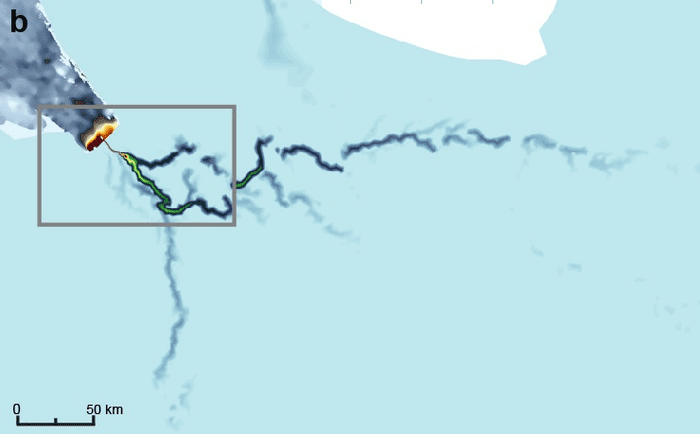Scientists have been surprised to discover a vast river larger than the Thames that runs beneath the Antarctic ice sheet. Building on previous observations, the latest study further shows how an interconnected network of rivers, lakes, and marine ecosystems can be found deep beneath this largely inaccessible and understudied chunk of the planet.
The river was recently discovered by researchers at Imperial College London, the University of Waterloo, Canada, Universiti Malaysia Terengganu, and Newcastle University. In a new study, the team used modeling and geophysical data from airborne radar surveys to gauge the size and dynamics of this colossal river.
Their results showed that it stretches for some 460 kilometers (907 miles), transporting large fluxes of freshwater at high pressure.
“When we first discovered lakes beneath the Antarctic ice a couple of decades ago, we thought they were isolated from each other. Now we are starting to understand there are whole systems down there, interconnected by vast river networks, just as they might be if there weren’t thousands of metres of ice on top of them,” Professor Martin Siegert, study co-author from the Grantham Institute at Imperial College London, said in a statement.

Model of the river system found beneath the Antarctic ice sheet. Image credit: Dow et al. 2022
One way in which water can appear beneath ice sheets is from water on the surface melting and running down through deep crevasses. This is what happens beneath Greenland in the North Pole, which sees heaps of melting over the summer months.
In Antarctica, the summers aren’t cold enough for this to happen. This has led scientists to believe there would be relatively little water at the base of the Antarctic ice sheets. However, it appears that a significant amount of water does emerge here, primarily driven by melting at the base of the ice sheet caused by the natural heat of the Earth and friction as the ice moves over land.
As exciting as this discovery may be, the flowing under-ice river may potentially be undermining the ice sheet by accelerating ice loss as the climate warms. The researchers were also interested to see how the presence of the river might be impacting predictions about how Antarctica will change in the face of climate change.
“The region where this study is based holds enough ice to raise the sea level globally by 4.3m. How much of this ice melts, and how quickly, is linked to how slippery the base of the ice is. The newly discovered river system could strongly influence this process,” explained Siegert.
The existence of this river and others like it also needs to be taken into account when predicting the possible impact of climate change in the region.
“From satellite measurements we know which regions of Antarctica are losing ice, and how much, but we don’t necessarily know why. This discovery could be a missing link in our models. We could be hugely underestimating how quickly the system will melt by not accounting for the influence of these river systems.
“Only by knowing why ice is being lost can we make models and predictions of how the ice will react in the future under further global heating, and how much this could raise global sea levels,” added lead researcher Dr Christine Dow from the University of Waterloo.
The new study was published in the journal Nature Geoscience.
Source Link: Giant River Bigger Than The Thames Unexpectedly Found Under Antarctica